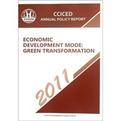中国环境与发展国际合作委员会2011年度政策报告
出版时间:2012-5 出版社:中国环境与发展国际合作委员会 中国环境科学出版社 (2012-05出版) 作者:中国环境与发展国际合作委员会 编 页数:372
内容概要
《中国环境与发展国际合作委员会2011年度政策报告:中国经济发展方式的绿色转型(英文版)》本年度政策报告综合了国合会2011年政策研究成果、国合会2011年年会给中国政府的政策建议、中国环境与发展重要政策进展(2010一2011年)和国合会政策建议影响,供国内各级决策者、专家、学者和公众参考。
书籍目录
Chapter 1 Policy Recommendations to the Government of China 1.1 Recommendation 1 : Rebuild Social Values, Adjust Government Roles,and Cultivate Human Resources to Reinforce and Serve an Unswerving National will on Green Transformation of Development Mode 1.2 Recommendation 2: Establish China's Green Economy System and Advance Green Transformation of the Existing Economic Development Mode 1.3 Recommendation 3: Build a Low Carbon Industrial System that Champions and Supports Green Transformation of Economic Development Mode 1.4 Recommendation 4: Develop a Green Trade and Investment System,Establish Green Supply Chains, and Champion a Goal-oriented GreenTransformative Strategy for China's Trade and Investment 1.5 Recommendation 5: Develop a Strategy and National Action Plan for Managing Mercury Use in China in order to Reduce Impacts on Public Health and on the Environment Chapter 2 Green Transformation of China's Economic Development Mode 2.1 Introduction 2.2 Transforming China's Economic Development Mode 2.3 Green Transformation 2.4 Green Transformation of China's Economic Development Mode-Five Challenges and Five Opportunities 2.5 Conclusion Chapter3 Development Mechanism and Policy Innovation of China's Green Economy 3.1 Introduction: the Taskforce and the Report 3.2 China's Green Economy Concept and Background 3.3 Structural Transformations and Green Initiatives-International Experience 3.4 Enabling Conditions: China-Specific Challenges and Opportunities 3.5 Strategic Framework and Indicator System 3.6 Key Tasks for China's Green Transformation and Development 3.7 Policy Measures to Support and Accelerate China's Green Transformation 3.8 Key Conclusions and Key Recommendations on Promoting China's Green Economy 3.9 Acknowledgments Chapter 4 China's Low Carbon Industrialization Strategy 4.1 Introduction 4.2 A Low Carbon Industrialization Strategy for China 4.3 Heavy Industry is Key in the Short to Medium Term 4.4 Emerging Industries-Catalysing Low Carbon Transformation 4.5 Recommendations Chapter 5 Investment, Trade, and Environment 5.1 The Relationship among Investment, Trade, and the Environment: Our Framework of Analysis 5.2 The Environmental Impact of Foreign Direct Investment (FDI) 5.3 EnvironmentaI and Social Impacts of Chinese ODI on Host Countries 5.4 International Trade and the Green Shift 5.5 China's Participation in International Rule-Making to Promote Environmental Protection 5.6 Policy Recommendations: Ideas for a Greener Future 5.7 Acknowledgements Chapter6 Practices and Innovation ofGreen Supply Chain 6.1 Background and Research Objectives 6.2 The Concept of Green Supply Chain 6.3 International Experiences of Green Supply Chain 6.4 Status Quo and Challenges of Green Supply Chain in China 6.5 Main Conclusions and Policy Recommendations 6.6 Acknowledgements Chapter 7 Mercury Management in China 7.1 Background 7.2 Mercury Pollution in China 7.3 International Experiences on Mercury Pollution Management 7.4 Strategy and Action Plan For Mercury Management in China 7.5 Recommendations For Priority Actions 7.6 Acknowledgments Appendix Ⅰ Progress on Environment and Development Policies in China (2010-2011) and CCICED Policy Recommendations Impact Appendix Ⅱ Name List of CouneiI Members
章节摘录
版权页: 插图: This is particularly true if the targets are focused on intensity reduction rather than total reduction of emissions,and also when economic growth rates are high so that improvements are masked by new forms,or levels,of environmental degradation.Additionally,there are significant monitoring and reporting issues,scientific unknowns about the nature of some problems (examples include the still emerging situation of soil pollution and the problems of water quality in coastal ocean areas),and cumulative impact matters that are significant at regional levels. This challenge may be further compounded if environmental impacts are re-directed from one part of China,or to another,or exported abroad,for example by meeting targets through purchase of commodities or other materials for use in China from countries where environmental considerations are not given adequate attention.Another problem is substitution of new environmental problems for old ones,for example,by changing production processes to ones that introduce new types of wastes.And,there is the need to consider equity concerns,for example,by reducing risk of disasters and health hazards in the process of relocating industrial processes,mining,etc. These are classic planning problems that can really only be resolved by taking an integrated approach to environment and economy decision making.The use of functional zoning can help,although care is required to ensure that greening of the economy in selected areas does not create zones of low environmental quality or loss of ecological services elsewhere.Adaptive planning and improved central government-local government coordination are critically important requirements. Better environmental monitoring,improvement in the compatibility of data sets,and building high credibility with the public through regular release of reliable,high quality environmental information including toxic substance inventories,environmental assessments,etc.,are important means to improve understanding of what is actually being accomplished in terms of improved environmental outcomes.
编辑推荐
《中国环境与发展国际合作委员会2011年度政策报告:中国经济发展方式的绿色转型(英文版)》由中国环境与发展国际合作委员会编著。
图书封面
评论、评分、阅读与下载
中国环境与发展国际合作委员会2011年度政策报告 PDF格式下载
